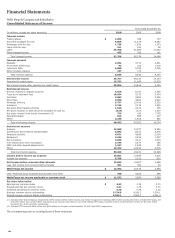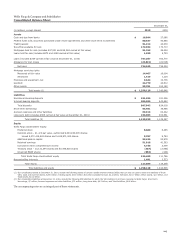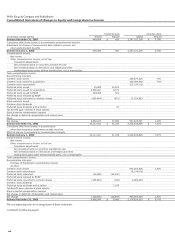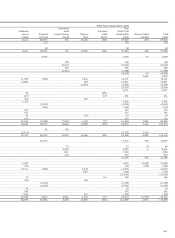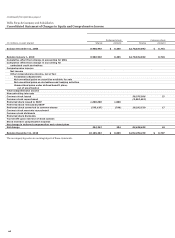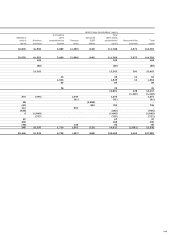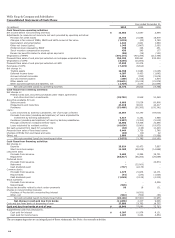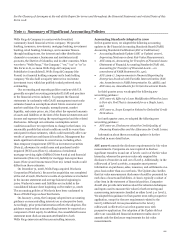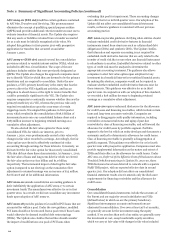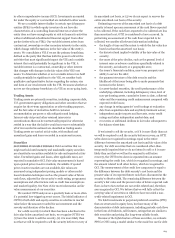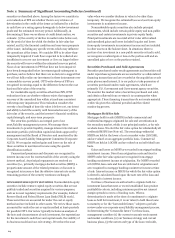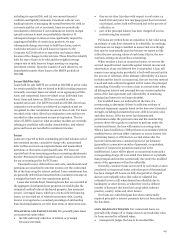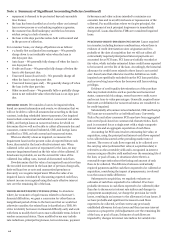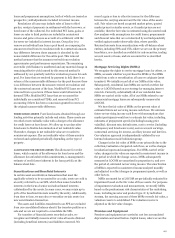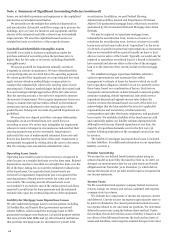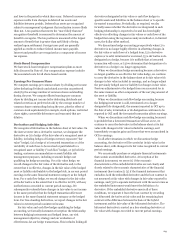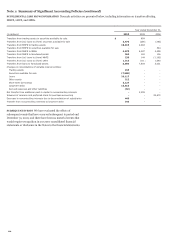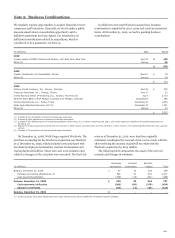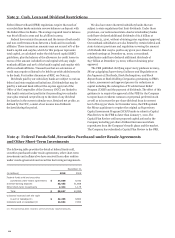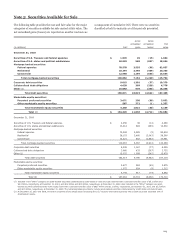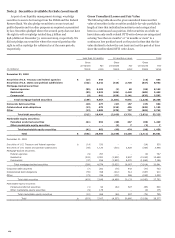Wells Fargo 2010 Annual Report Download - page 116
Download and view the complete annual report
Please find page 116 of the 2010 Wells Fargo annual report below. You can navigate through the pages in the report by either clicking on the pages listed below, or by using the keyword search tool below to find specific information within the annual report.Note 1: Summary of Significant Accounting Policies (continued)
securities as described above. Among the factors we consider in
our evaluation of PPS are whether there is any evidence of
deterioration in the credit of the issuer as indicated by a decline
in cash flows or a rating agency downgrade to below investment
grade and the estimated recovery period. Additionally, in
determining if there was evidence of credit deterioration, we
evaluate: (1) the severity of decline in market value below cost,
(2) the period of time for which the decline in fair value has
existed, and (3) the financial condition and near-term prospects
of the issuer, including any specific events which may influence
the operations of the issuer. We consider PPS to be other-than-
temporarily impaired if cash flows expected to be collected are
insufficient to recover our investment or if we no longer believe
the security will recover within the estimated recovery period.
None of our investments in PPS that have not been impaired
have been downgraded below investment grade subsequent to
purchase, and we believe that there are no factors to suggest that
we will not fully realize our investment in these instruments over
a reasonable recovery period. OTTI write-downs of PPS are
recognized in earnings equal to the difference between the cost
basis and fair value of the security.
For marketable equity securities other than PPS, OTTI
evaluations focus on whether evidence exists that supports
recovery of the unrealized loss within a timeframe consistent
with temporary impairment. This evaluation considers the
severity of and length of time fair value is below cost, our intent
and ability to hold the security until forecasted recovery of the
fair value of the security, and the investee's financial condition,
capital strength, and near-term prospects.
The securities portfolio is an integral part of our
asset/liability management process. We manage these
investments to provide liquidity, manage interest rate risk and
maximize portfolio yield within capital risk limits approved by
management and the Board of Directors and monitored by the
Corporate Asset/Liability Management Committee (Corporate
ALCO). We recognize realized gains and losses on the sale of
these securities in noninterest income using the specific
identification method.
Unamortized premiums and discounts are recognized in
interest income over the contractual life of the security using the
interest method. As principal repayments are received on
securities (i.e., primarily mortgage-backed securities (MBS)) a
proportionate amount of the related premium or discount is
recognized in income so that the effective interest rate on the
remaining portion of the security continues unchanged.
NONMARKETABLE EQUITY SECURITIES Nonmarketable equity
securities include venture capital equity securities that are not
publicly traded and securities acquired for various purposes,
such as to meet regulatory requirements (for example, Federal
Reserve Bank and Federal Home Loan Bank (FHLB) stock).
These securities are accounted for under the cost or equity
method and are included in other assets. We review those assets
accounted for under the cost or equity method at least quarterly
for possible OTTI. Our review typically includes an analysis of
the facts and circumstances of each investment, the expectations
for the investment's cash flows and capital needs, the viability of
its business model and our exit strategy. We reduce the asset
value when we consider declines in value to be other than
temporary. We recognize the estimated loss as a loss from equity
investments in noninterest income.
Nonmarketable equity securities also include principal
investments, which include certain public equity and non-public
securities and certain investments in private equity funds.
Principal investments are recorded at fair value with realized
and unrealized gains and losses included in gains and losses
from equity investments in noninterest income and are included
in other assets on the balance sheet. In situations where a
portion of an investment in a non-public security or fund is sold,
we recognize a realized gain or loss on the portion sold and an
unrealized gain or loss on the portion retained.
Securities Purchased and Sold Agreements
Securities purchased under resale agreements and securities sold
under repurchase agreements are accounted for as collateralized
financing transactions and are recorded at the acquisition or sale
price plus accrued interest. It is our policy to take possession of
securities purchased under resale agreements, which are
primarily U.S. Government and Government agency securities.
We monitor the market value of securities purchased and sold,
and obtain collateral from or return it to counterparties when
appropriate. These financing transactions do not create material
credit risk given the collateral provided and the related
monitoring process.
Mortgages Held for Sale
Mortgages held for sale (MHFS) include commercial and
residential mortgages originated for sale and securitization in
the secondary market, which is our principal market, or for sale
as whole loans. We elect the fair value option for substantially all
residential MHFS (see Note 16). The remaining residential
MHFS are held at the lower of cost or market value (LOCOM),
and are valued on an aggregate portfolio basis. Commercial
MHFS are held at LOCOM and are valued on an individual loan
basis.
Gains and losses on MHFS are recorded in mortgage banking
noninterest income. Direct loan origination costs and fees for
MHFS under fair value option are recognized in mortgage
banking noninterest income at origination. For MHFS recorded
at LOCOM, loan costs and fees are deferred at origination and
are recognized in mortgage banking noninterest income at time
of sale. Interest income on MHFS for which the fair value option
is elected is calculated based upon the note rate of the loan and
is recorded to interest income.
Our lines of business are authorized to originate held-for-
investment loans that meet or exceed established loan product
profitability criteria, including minimum positive net interest
margin spreads in excess of funding costs. When a
determination is made at the time of commitment to originate
loans as held for investment, it is our intent to hold these loans
to maturity or for the “foreseeable future,” subject to periodic
review under our corporate asset/liability management process.
In determining the “foreseeable future” for these loans,
management considers (1) the current economic environment
and market conditions, (2) our business strategy and current
business plans, (3) the nature and type of the loan receivable,
114


